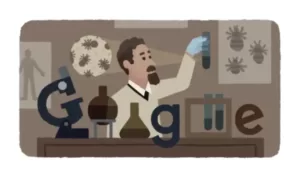
| Translate This News In |
|---|
On September 2, a Google Doodle honoured Polish inventor, doctor, and immunologist Rudolf Weigl’s 138th birthday with an animated graphic. Rudolf Weigl is credited for developing the first successful vaccination for epidemic typhus, one of the world’s oldest and most contagious diseases.
Rudolf Weigl is pictured carrying a test tube in his gloved hands in today’s special Google Doodle. On both sides of the wall are drawings of lice and a human body. On the doodle, Google is spelt out with bunsen burners, a microscope, and beakers on a lab table.

Rudolf Weigl, who was he?
On September 2, 1883, Rudolf Stefan Weigl was born in the Austro-Hungarian town of Przerow (now Czech Republic). In 1914, the Polish inventor completed his studies in biological sciences at Lwow University and was assigned to the Polish Army as a parasitologist.
Because millions of people in Eastern Europe were infected with typhus, Rudolf Weigl was motivated to eradicate the disease.
Weigl turned the tiny bug into a laboratory specimen since body lice were known to transmit the typhus-infecting bacteria Rickettsia prowazekii. His groundbreaking discovery discovered how to utilise lice to spread the deadly bacteria that he had been researching for decades in the hopes of creating a vaccine. Weigl’s vaccine successfully infected its first recipient in 1936. Weigl was compelled to construct a vaccine production plant when Germany conquered Poland at the onset of World War II. He used the service to hire friends and colleagues who were at risk of persecution under the new regime,” according to the Google Doodle.
Around 5,000 individuals were rescued thanks to Rudolf Weigl’s actions, “both due to his direct attempts to safeguard his neighbours and the thousands of vaccine doses provided statewide.”
“Weigl is now largely regarded as a brilliant scientist and hero. Not one, but two Nobel Prize nominations have been made in his honour. The effects of your tireless work on the world are felt to this day—Happy Birthday, Rudolf Weigl,” Google Doodle says. “From studying a tiny louse to saving thousands of human lives, the impacts of your tireless work on the world are felt to this day—Happy Birthday, Rudolf Weigl,” Google Doodle says.

















